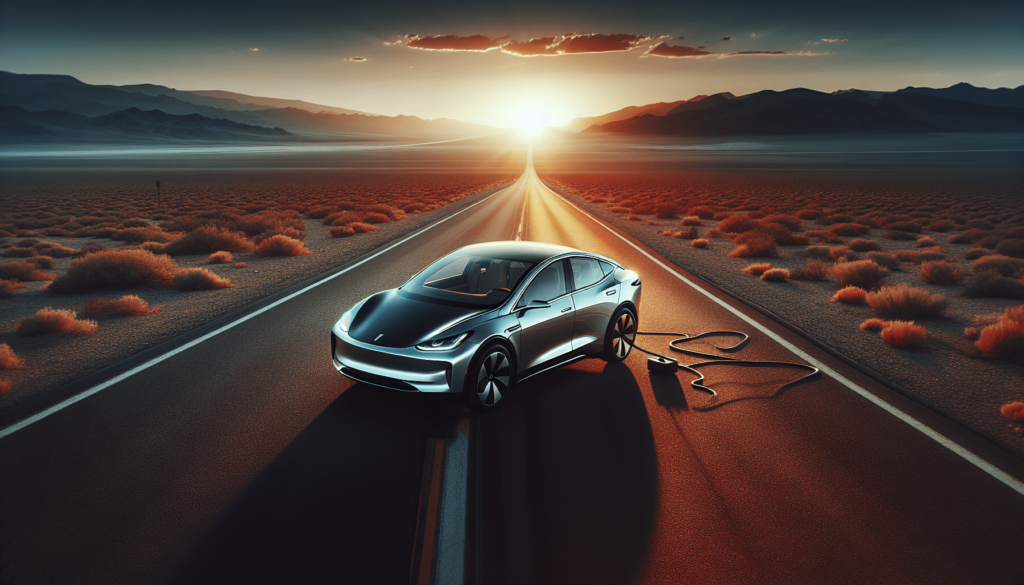Picture this: You’re cruising along in your electric car, your favorite tunes playing, when suddenly, the unthinkable happens – your car runs out of battery, miles away from the nearest charging station. Panic sets in. What do you do? Can you simply push your electric vehicle to safety, or are you stranded waiting for a tow truck? This article explores the pivotal question: Can you push an electric car if it runs out of battery? Sit tight as we unravel this intriguing query, ensuring you’re never left feeling powerless again.
Understanding Electric Vehicles
How electric cars work
You might be curious about how electric cars zip down the road without a drop of gasoline. Well, it’s simpler than you might think. Electric vehicles (EVs) run on electricity, obviously, sourced from batteries installed within the car. When you press the accelerator, electricity from the battery is sent to the motor, which then turns the wheels. It’s a clean, efficient process with fewer moving parts compared to traditional cars – meaning, less wear and tear.
Differences between electric and conventional vehicles
The main difference between electric and conventional vehicles lies in the heart of their operations. Conventional vehicles rely on internal combustion engines that burn fuel to produce power. On the flip side, electric vehicles use electric motors powered by electricity stored in batteries. This foundational difference extends to other areas, too, such as maintenance requirements (EVs generally require less) and driving experience (many drivers find electric vehicles smoother and quieter).
The role of the battery in electric vehicles
The battery in an electric vehicle isn’t just another component; it’s the lifeline of the car. It determines how far you can go on a single charge – what we call the ‘range’. It also influences the vehicle’s performance, including its acceleration and top speed. Keeping the battery in good health is crucial for maximizing both the lifespan of the vehicle and your enjoyment of driving it.
The Scenario of a Depleted Battery
What happens when an electric car runs out of battery?
Running out of battery in an EV is akin to running out of gas in a conventional car. The vehicle will eventually come to a stop. You won’t suddenly lose control or come to an abrupt halt (assuming the vehicle’s battery management system gives you ample warning), but you will need to find a way to recharge or seek assistance to get moving again.
Immediate implications for the driver
When your electric car runs out of battery, your immediate concern is figuring out what to do next. This might involve calling roadside assistance, looking up the nearest charging station, or figuring out if there’s any way to get a boost charge to get you moving.
Safety considerations in a power loss situation
In a situation where your EV runs out of juice, safety should be your paramount concern. Make sure to pull over safely to the roadside. Use your vehicle’s hazard lights to alert other drivers, and if possible, place a reflective triangle or wear a high-visibility vest if you need to exit the vehicle.

Can You Push An Electric Car?
Physical feasibility of pushing an electric vehicle
Yes, you can push an electric vehicle if it runs out of battery, but it’s not always straightforward. Electric cars are generally heavier than their gasoline counterparts due to the weight of the battery. This means you’ll need more muscle power to push an EV compared to pushing a conventional car.
Comparing to pushing a conventional vehicle
Pushing a conventional vehicle, you’re mainly overcoming the friction of the tires and the engine’s internal resistance if it’s not running. In an electric vehicle, besides the weight, you might also be dealing with the regenerative braking system that can add resistance, making it harder to push.
Understanding the weight and resistance factors
The weight of the electric vehicle is a significant factor when it comes to pushing it. But also, the electrical systems can add resistance. Some vehicles might allow you to disengage these systems for towing or pushing, but this often requires specific steps that vary from one model to another.
The Role of Vehicle Electronics
How electronics influence the pushability of an electric car
Electronics in an electric vehicle can indeed affect its ‘pushability’. For example, the vehicle’s ability to free-wheel (move without power) may be electronically controlled. Without battery power, some vehicles automatically engage brakes or won’t easily disengage the transmission, making them harder to move.
Locked vs. unlocked transmission systems
In some electric cars, the transmission system can lock up if the vehicle’s electronics aren’t powered. This is a security feature but can be a hassle if you’re trying to push the car to a safer location or onto a tow truck.
Electronic parking brakes and their impact
Electronic parking brakes automatically engage in many modern vehicles, including EVs, when they sense the vehicle is parked without power. While this feature enhances safety, it can also prevent the car from being pushed unless you can manually disengage the brake, which usually requires some battery power.

Manual Override Systems
What manual override systems exist in electric cars?
Many electric vehicles have some form of manual override that allows you to disengage the electronic systems that might prevent pushing or towing. This might be a physical lever inside the vehicle or a sequence of actions indicated in the owner’s manual.
How to activate manual towing mode, if available
If your electric vehicle is equipped with a manual towing mode, you’ll typically activate it through a sequence of controls. This might include pressing a specific combination of buttons or using the in-car infotainment system. The exact process can usually be found in your vehicle’s manual.
The significance of reading the vehicle’s manual
Knowing how to activate the manual override or towing mode of your electric vehicle underscores the importance of familiarizing yourself with your vehicle’s manual. It’s packed with crucial information that can help you handle tricky situations like a dead battery far from a charging station.
Safety Precautions When Pushing
Recommended safety gear
When attempting to push your electric vehicle, wearing safety gear is essential. This includes gloves to protect your hands, durable shoes, and a high-visibility vest, especially if you’re on a busy road.
Ensuring visibility to other drivers
Apart from wearing high-visibility clothing, ensure your vehicle is visible to other drivers. Use reflective triangles, hazard lights, and any other safety signals at your disposal to alert passing drivers to your presence and situation.
Proper techniques for pushing an electric vehicle safely
Pushing an electric vehicle requires proper technique to avoid injury. Ensure you push with your legs rather than your back to minimize strain. Also, it’s best done with assistance — having one person steer while others push. Always push from the vehicle’s side, not directly behind it, to avoid being injured if the car suddenly moves.

Alternative Solutions to a Dead Battery
Towing services specialized for electric vehicles
If pushing isn’t an option, consider calling a towing service that specializes in electric vehicles. They’ll have the knowledge and equipment to safely tow your EV without causing damage, especially to the battery or electrical systems.
Portable battery chargers and their effectiveness
Portable battery chargers can provide your EV with a quick boost that might be enough to get you to a nearby charging station. However, their effectiveness varies and they are generally more suitable for emergencies rather than a replacement for proper charging.
Locating nearby charging stations via apps
Several apps can help you locate the nearest charging station. These are invaluable in an emergency or when planning trips, ensuring you’re never too far from a charging point.
The Importance of Regular Battery Maintenance
Preventive measures to avoid battery depletion
The best way to handle a dead battery scenario is to prevent it. Regularly monitor your battery’s health and charge levels. Most EVs offer apps that let you check your battery status and plan your trips accordingly to avoid running low on power.
Understanding battery lifespan and health
Battery health is crucial for maintaining your vehicle’s range and performance. Over time, batteries degrade, reducing their capacity. By understanding the factors that affect battery health, such as temperature and charging habits, you can take steps to prolong its life.
Tips for extending battery life and performance
To extend your battery’s life, avoid exposing your vehicle to extreme temperatures for prolonged periods. Also, it’s recommended to keep your battery’s charge between 20% and 80% to minimize wear. Regular software updates can also optimize battery management systems for better performance and longevity.

Legal Considerations and Responsibilities
Laws and regulations about pushing vehicles on public roads
Pushing a vehicle on public roads is subject to local laws and regulations. In some places, it may be illegal or only allowed under specific conditions. Always familiarize yourself with the legal requirements in your area to avoid penalties.
The driver’s responsibility in case of a breakdown
In the case of a breakdown, the driver’s responsibility is to ensure their safety and that of other road users. This means moving the vehicle out of the flow of traffic if possible and signaling other drivers. Understanding the correct procedures can help make the situation safer for everyone.
Insurance implications of manually moving a vehicle
Before attempting to push your electric vehicle, check your insurance policy. Some policies might have specific clauses about manual moving of the vehicle, which could affect your coverage in case of damage or accidents during the process.
Conclusion: Preparing for the Unexpected
The importance of being prepared for a dead battery
Being prepared for a dead battery can significantly reduce the stress and inconvenience of such a situation. This means knowing your vehicle’s range, understanding how to activate its manual override systems, and having a plan for what to do if you run out of power.
Emergency kits and contact numbers for assistance
It’s wise to keep an emergency kit in your vehicle, including safety gear, portable chargers, and basic tools. Also, have the contact numbers for roadside assistance and towing services that can handle electric vehicles.
Revisiting the feasibility and advisability of pushing an electric car
So, can you push an electric car if it runs out of battery? Yes, but whether you should is another matter. It’s physically demanding, possibly illegal depending on your location, and could be risky without proper precautions. It’s far better to prevent the situation entirely with regular battery maintenance and careful planning. But if you’re caught out, knowing how to handle it safely and legally is invaluable.

